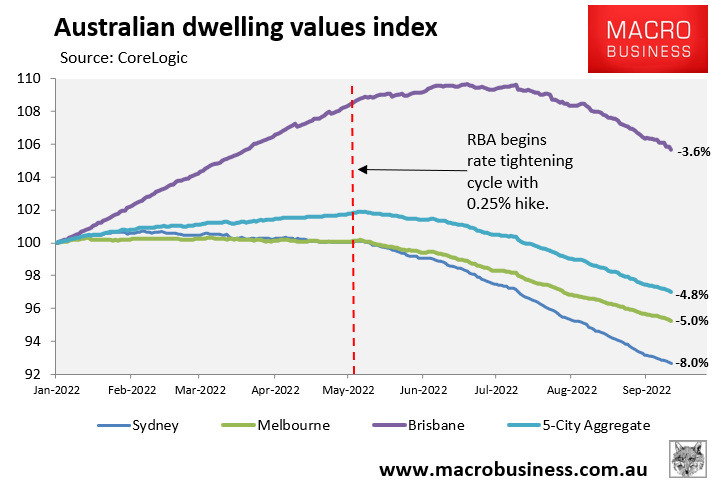Coolabah Capital’s Chris Joye and economist Stephen Koukoulas (‘the Kouk’) have given two opposite perspectives on Australia’s housing correction.
The Kouk claims that Australia’s house price correction is nothing special and maintains his forecast of a 7% peak-to-trough decline nationally:
Recent data on house sales show auction clearance rates have stopped deteriorating…
Also supporting the housing market is data from SQM Research, showing the supply of new listings for sale.
This has been weak, which suggests there is little or no forced selling…
The risk for the economy and banks from a catastrophic house price fall remains low. While prices are likely to drop a bit more in the next few months, there could well be a bottoming in house prices in the early part of 2023.
The nation-wide peak-to-trough fall in house prices is still on track to be around 7 per cent when that point is reached in the new year.
Not so, says Coolabah Capital’s Chris Joye. He claims prices are plummeting across the East Coast and are on track for a “record housing correction”. Joye maintains his forecast of a 15-25% peak-to-trough decline in national dwelling values:
Australian home values are now shrinking at an annualised rate that exceeds 15% based on the three months of CoreLogic compositionally-adjusted index data…
In Australia’s largest city, Sydney, the annual pace of house price depreciation has stabilised at a hefty 22% since late August. Property values in the nation’s second largest metropolis, Melbourne, are falling at 14-15% annualised clip.
While the two biggest conurbations have led what is bound to become a record housing correction since the RBA started lifting interest rates in May 2022, there is nascent evidence that the third largest city, Brisbane, is quickly catching up. In the month of August, Sydney home values tumbled by 2.3%, the worst monthly loss since the early 1980s.
Regular readers will know that I am firmly in the camp of Chris Joye.
While it is still early days, the pace of price decline has been stunning since the Reserve Bank of Australia (RBA) first began hiking rates:

Australian house price fall sharply.
Dwelling values at the 5-City level have already fallen 4.8%, led by an 8.0% decline across Sydney, a 5.0% fall across Melbourne, and a 3.6% fall across Brisbane.
The RBA’s latest Financial Stability Review estimated “that a 200-basis-point increase in interest rates from current levels would lower real housing prices by around 15 per cent over a two-year period”.
Given the cash rate has already risen by 2.25% and further rate hikes are a certainty, Chris Joye’s projected 15-20% peak-to-trough decline in national dwelling values is far more plausible than the Kouk’s 7% projected fall. This is especially so given we are already more than halfway to Kouk’s target and there is a two-to-three-month lag between RBA rate hikes and the impact on mortgage holders.

